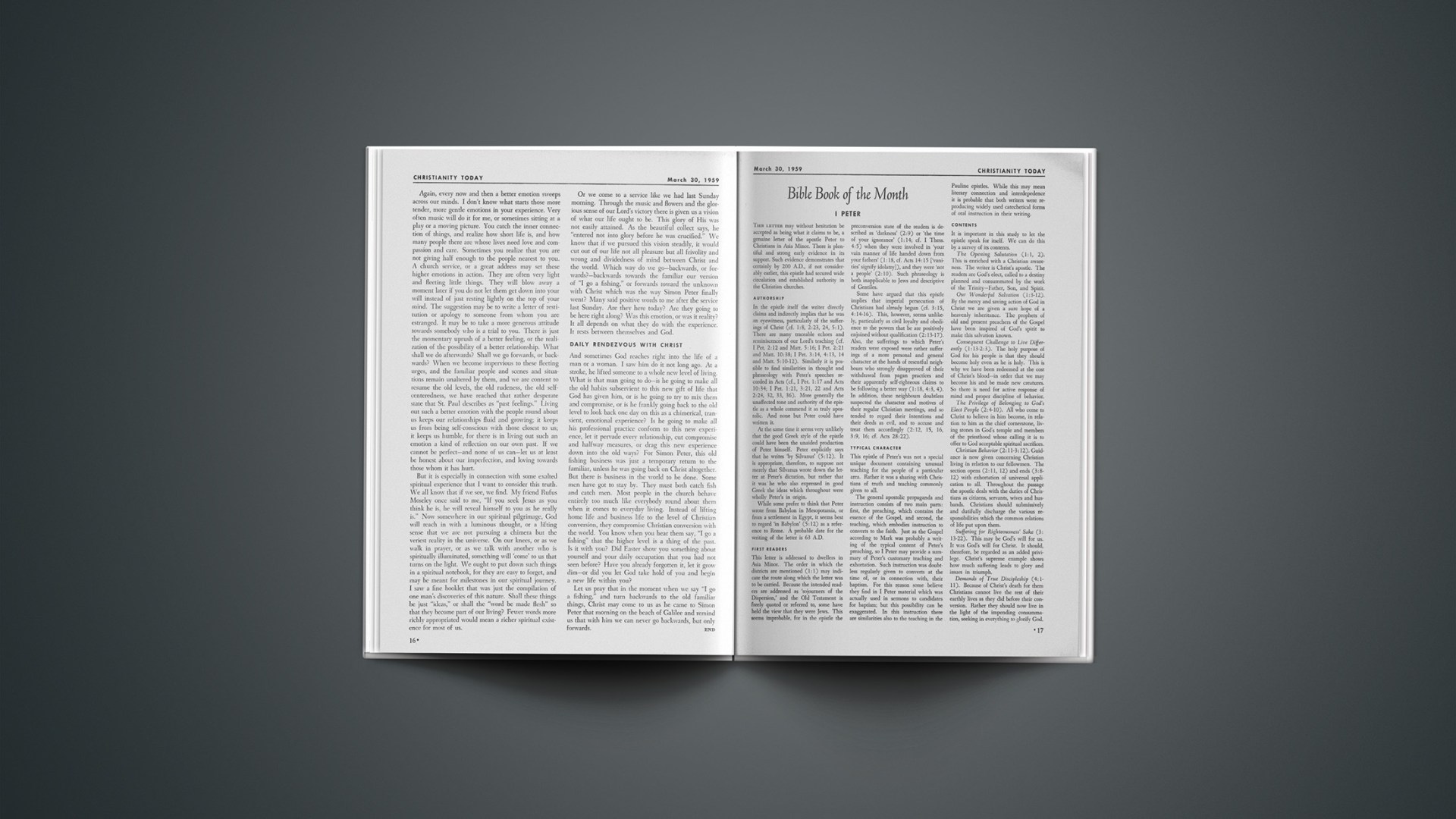This letter may without hesitation be accepted as being what it claims to be, a genuine letter of the apostle Peter to Christians in Asia Minor. There is plentiful and strong early evidence in its support. Such evidence demonstrates that certainly by 200 A.D., if not considerably earlier, this epistle had secured wide circulation and established authority in the Christian churches.
Authorship
In the epistle itself the writer directly claims and indirectly implies that he was an eyewitness, particularly of the sufferings of Christ (cf. 1:8; 2:23, 24; 5:1). There are many traceable echoes and reminiscences of our Lord’s teaching (cf. 1 Pet. 2:12 and Matt. 5:16; 1 Pet. 2:21 and Matt. 10:38; 1 Pet. 3:14; 4:13, 14 and Matt. 5:10–12). Similarly it is possible to find similarities in thought and phraseology with Peter’s speeches recorded in Acts (cf., 1 Pet. 1:17 and Acts 10:34; 1 Pet. 1:21; 3:21, 22 and Acts 2:24, 32, 33, 36). More generally the unaffected tone and authority of the epistle as a whole commend it as truly apostolic. And none but Peter could have written it.
At the same time it seems very unlikely that the good Greek style of the epistle could have been the unaided production of Peter himself. Peter explicitly says that he writes ‘by Silvanus’ (5:12). It is appropriate, therefore, to suppose not merely that Silvanus wrote down the letter at Peter’s dictation, but rather that it was he who also expressed in good Greek the ideas which throughout were wholly Peter’s in origin.
While some prefer to think that Peter wrote from Babylon in Mesopotamia, or from a settlement in Egypt, it seems best to regard ‘in Babylon’ (5:12) as a reference to Rome. A probable date for the writing of the letter is 63 A.D.
First Readers
This letter is addressed to dwellers in Asia Minor. The order in which the districts are mentioned (1:1) may indicate the route along which the letter was to be carried. Because the intended readers are addressed as ‘sojourners of the Dispersion,’ and the Old Testament is freely quoted or referred to, some have held the view that they were Jews. This seems improbable, for in the epistle the preconversion state of the readers is described as ‘darkness’ (2:9) or ‘the time of your ignorance’ (1:14; cf. 1 Thess. 4:5) when they were involved in ‘your vain manner of life handed down from your fathers’ (1:18, cf. Acts 14:15 [‘vanities’ signify idolatry]), and they were ‘not a people’ (2:10). Such phraseology is both inapplicable to Jews and descriptive of Gentiles.
Some have argued that this epistle implies that imperial persecution of Christians had already begun (cf. 3:15; 4:14–16). This, however, seems unlikely, particularly as civil loyalty and obedience to the powers that be are positively enjoined without qualification (2:13–17). Also, the sufferings to which Peter’s readers were exposed were rather sufferings of a more personal and general character at the hands of resentful neighbours who strongly disapproved of their withdrawal from pagan practices and their apparently self-righteous claims to be following a better way (1:18; 4:3, 4). In addition, these neighbours doubtless suspected the character and motives of their regular Christian meetings, and so tended to regard their intentions and their deeds as evil, and to accuse and treat them accordingly (2:12, 15, 16; 3:9, 16; cf. Acts 28:22).
Typical Character
This epistle of Peter’s was not a special unique document containing unusual teaching for the people of a particular area. Rather it was a sharing with Christians of truth and teaching commonly given to all.
The general apostolic propaganda and instruction consists of two main parts: first, the preaching, which contains the essence of the Gospel, and second, the teaching, which embodies instruction to converts to the faith. Just as the Gospel according to Mark was probably a writing of the typical content of Peter’s preaching, so I Peter may provide a summary of Peter’s customary teaching and exhortation. Such instruction was doubtless regularly given to converts at the time of, or in connection with, their baptism. For this reason some believe they find in I Peter material which was actually used in sermons to candidates for baptism; but this possibility can be exaggerated. In this instruction there are similarities also to the teaching in the Pauline epistles. While this may mean literary connection and interdepedence it is probable that both writers were reproducing widely used catechetical forms of oral instruction in their writing.
Contents
It is important in this study to let the epistle speak for itself. We can do this by a survey of its contents.
The Opening Salutation (1:1, 2). This is enriched with a Christian awareness. The writer is Christ’s apostle. The readers are God’s elect, called to a destiny planned and consummated by the work of the Trinity—Father, Son, and Spirit.
Our Wonderful Salvation (1:3–12). By the mercy and saving action of God in Christ we are given a sure hope of a heavenly inheritance. The prophets of old and present preachers of the Gospel have been inspired of God’s spirit to make this salvation known.
Consequent Challenge to Live Differently (1:13–2:3). The holy purpose of God for his people is that they should become holy even as he is holy. This is why we have been redeemed at the cost of Christ’s blood—in order that we may become his and be made new creatures. So there is need for active response of mind and proper discipline of behavior.
The Privilege of Belonging to God’s Elect People (2:4–10). All who come to Christ to believe in him become, in relation to him as the chief cornerstone, living stones in God’s temple and members of the priesthood whose calling it is to offer to God acceptable spiritual sacrifices.
Christian Behavior (2:11–3:12). Guidance is now given concerning Christian living in relation to our fellowmen. The section opens (2:11, 12) and ends (3:8–12) with exhortation of universal application to all. Throughout the passage the apostle deals with the duties of Christians as citizens, servants, wives and husbands. Christians should submissively and dutifully discharge the various responsibilities which the common relations of life put upon them.
Suffering for Righteousness’ Sake (3:13–22). This may be God’s will for us. It was God’s will for Christ. It should, therefore, be regarded as an added privilege. Christ’s supreme example shows how much suffering leads to glory and issues in triumph.
Demands of True Discipleship (4:1–11). Because of Christ’s death for them Christians cannot live the rest of their earthly lives as they did before their conversion. Rather they should now live in the light of the impending consummation, seeking in everything to glorify God.
Suffering for Christ’s sake (4:12–19). Trial and suffering endured because of our Christian faith should be regarded not with surprise or shame, but with rejoicing, as a means of glorifying God, and as holding promise of fuller participation in Christ’s glory, yet to be manifested.
Elders Exhorted (5:1–4). Elders are given instruction as to the proper discharge of pastoral care in local churches. They are to lead by example, not by dominance.
Need for Humility and Endurance (5:5–9). Christians must learn before God and men to exhibit a submissive spirit, and to be steadfast and unflinching in devotion.
Final Prayer and Greeting (5:10–14). God can be counted upon to establish, preserve, and strengthen his own. Such is the true character of his grace. Let his people express brotherly love and enjoy the peace that God gives.
Teaching
Much profound and practical theology is here inculcated. Notice some aspects of the important truths that are treated.
God’s Sovereignty, Character, and Ways. An awareness of God as the Judge of all men should give to our present living a reverence and confidence, restraint and hope. For he resists the proud and opposes evildoers. He gives grace to the humble, and in the end, vindicates and rewards all who submit to his ways. Since he raised Christ, who died for us, from the dead, we have solid ground for making God himself our confidence and hope. Indeed, since he cares for us, we can cast all our anxiety upon him. We are to find happiness in him and to spend our lives doing his will.
Christ’s Person and Work. Jesus, the Son of God, fulfilled in the flesh of man a purpose divinely foreordained to redeem God’s people by his sacrificial death on the Cross. His death was penal, substitutionary, and reconciling—“the righteous for the unrighteous, that he might bring us to God.” His heavenly glories follow in consequence of his earthly suffering. He is now enthroned at God’s right hand as Lord over all. His glory is yet to be manifested. Meanwhile communion with him is enjoyed by his people through the response of personal love, faith, and committal; and the way in which he lived his earthly life is the example we are to follow. On the other hand, to those who in rebellion are disobedient to his commands, the same Christ will bring inevitable judgment.
The People of God. Peter addresses his readers as people who have been given a new status, experience, and hope by the eternal determination and earthly intervention of the living God. He speaks of their divine election, redemption, and sanctification. He contrasts their heavenly calling and destiny with their present earthly sojourning. Their full salvation has yet to be made manifest in the fulness of God’s time. But their present earthly lives should be lived with this consummation in view. They are but strangers and pilgrims here.
Christian Behavior. Those who have thus become God’s people in Christ must disclose their new relationship and status by radical changes of conduct. They must cease from the practice of sin and become holy. They must persistently do good, even when they have to suffer for doing it; and thus they are to witness in every human relationship by well-doing. Following Christ’s example, they must be patient in enduring unjust suffering.
Commentaries
The following books are helpful in the study of I Peter: Robert Leighton, A Practical Commentary upon I Peter (many editions); John Brown, Expository Discourses on I Peter (Edinburgh, Oliphants, three vols. 1886); F. J. A. Hort, The First Epistle of St. Peter (London, Macmillan, 1898); C. Bigg, The Epistles of St. Peter and St. Jude in The International Critical Commentary (Edinburgh, T. and T. Clark, 1901); G. W. Blenkin, The First Epistle General of Peter (Cambridge University Press, 1914); E. G. Selwyn, The First Epistle of St. Peter (London, Macmillan, 1946), C. E. B. Cranfield, The First Epistle of Peter (London, S. C. M. Press, 1950).
ALAN M. STIBBS
Vice Principal
Oak Hill Theological College, London
• For a detailed discussion of points raised in the above article, readers are referred to an excellent study of the epistle in the Tyndale commentary series, I Peter, by Alan M. Stibbs, published in the United States by Eerdmans—ED.










